Student | Web Site |
Andrew Baker | |
Logan Droppa | |
Jason Freeman | |
David Gillen | |
Darren Krebs | |
Josh Reiter | |
Matt Reitzel | |
Tiffany Roddy | |
Ryan Thrush | |
John Westerfer | |
Chance Yeckley |
Forest technology at Penn State Mont Alto and comments on forestry in general.
Tuesday, November 28, 2006
Forester Web Sites
In the Forestry Computer Applications course students learn many computer techniques that are needed in forestry such as spreadsheets and document preparation. Communication in the digital requires knowledge of the web. Here are the sites that this fall's students are developing. Remember, they are works in progress.
Sunday, November 26, 2006
Pennsylvania Deer Season

Tomorrow is the start of Pennsylvania's two week statewide deer hunting season. As this article in the Harrisburg Patriot News shows there is still a great deal of mistrust among hunters of the increased doe limits and the concurrent doe and buck season. (See the PA Game Commission site, where I linked to this picture.)
Many of the hunters are saying that deer are becoming scarcer and harder to find. The article points out that with more bucks surviving each year, they are becoming more wily and better able to evade hunters. In any case, it's still true that in much of Pennsylvania it is impossible to regenerate a hardwood forest without a big investment in deer fencing. See my previous post. It doesn't make sense to allow one use of the forest (deer hunting) to monopolize all the other uses and even deter efforts to regenerate forests for future use.
I truly hope this year's hunt goes off in safety with no hunter accidents.
Wednesday, November 22, 2006
The Shifting North Pole

The December 2006 National Geographic has an amazing map of the 700 mile movement of the North Magnetic Pole since its discovery in 1831. If it keeps on moving like it has in the past, it will be in Russia in a few years. The accompanying notes by Joel K. Bourne, Jr. indicates the pole is moving at a rate of 25 miles a year! The article suggests that "... it might be be time to trade that trusty compass for a handheld GPS."
Actually, compasses are very reliable on a day to day basis while GPS receivers are subject to periodic outages and loss of signal under certain conditions. I recommend carrying both into the field. A magnetic compass needs no batteries, while a GPS offers a large number of navigation and tracking tools.
I looked on the National Geographic web site to see if the map in the magazine is online. As of today it isn't. But they do have this news article from last December describing research by Joe Stoner, a paleomagnetist at Oregon State University. He has found that the movement of the pole is completely normal. It gives researchers a window into the liquid iron core at the center of the earth. It also influences the aurora borealis!
Monday, November 20, 2006
Forest Fires and Global Warming
Mont Alto alumnus Eric Straley sent me this news link http://news.yahoo.com/s/ap/20061116/ap_on_sc/cooling_fires about a study of the long term effects of forest fires in northern (spruce fir) forests. It seems that the fire releases large quantities of carbon and pollutants at first. But the next year the same site with longer lasting snow cover and light-colored hardwood regrowth will actually reflect light back to space which would reduce global warming. It takes at least 80 years for the dark-colored softwood forest to be re-established.
The article quotes the researchers as saying that wildfires are just one factor in global warming and this issue needs more study to understand what's going on. However, as global warming is a long term phenomenon made up of the sum of all activities on earth I get a little skeptical about the importance of individual studies of one part of a very complicated system. It's not enough to really decided how to change policies and actions.
Thanks, Eric, for the interesting article and stay warm in Anchorage, AL!
The article quotes the researchers as saying that wildfires are just one factor in global warming and this issue needs more study to understand what's going on. However, as global warming is a long term phenomenon made up of the sum of all activities on earth I get a little skeptical about the importance of individual studies of one part of a very complicated system. It's not enough to really decided how to change policies and actions.
Thanks, Eric, for the interesting article and stay warm in Anchorage, AL!
Wednesday, November 15, 2006
Ann Frank Chestnut Tree to be Cut Down

Officials in Amsterdam have concluded that the Anne Frank chestnut tree is too badly infected to be saved and should be cut down. According to news accounts the 150-170 year old tree has been attacked has been attacked by an aggressive fungus and a moth, called the horse chestnut leaf miner.
In her diary, written while her family was hiding from the Nazis in an apartment in a nearby warehouse the teenage Anne wrote movingly how the tree inspired her and gave her hope.
Here is a link to a website with information on the tree and the people it has inspired. Officials at the Anne Frank museum are planning to plant a new chestnut sapling after the old tree has been removed in the next few weeks.
Sunday, November 12, 2006
Google vs. Yahoo! Imagery
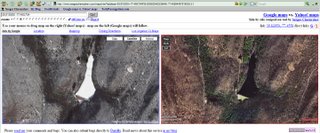
The image above is a screen capture from an amazing map hack by Sergey Chernyshev that puts Google (left) and Yahoo! maps side by side. To get the above comparison of the Waynesboro Reservoir in the Waynesboro Watershed (where we hold many labs in the Penn State Mont Alto forest technology program) first go to this web address: http://www.sergeychernyshev.com/maps.html . Then enter these search coordinates: 39.818300 -77.455734 (latitude and longitude). Make sure to choose satellite imagery to see just the images or hybrid to see the images and roads.
Both images are high resolution, high quality. Online mapping services tend to have spotty coverage of the best imagery around the US. Google shows a winter scene, where the reservoir is frozen. Yahoo! shows a slightly color enhanced summer scene. The road networks use the same data from Navteq. It' great to be able to see them together side by side.
Online mapping is a trend. It's likely that foresters and other natural resource managers will be using these tools in the future to improve their understanding of the forests and to make field work more efficient. Thanks, Sergey, for this new tool.
Wednesday, November 08, 2006
Plant a Billion Trees
http://www.foxnews.com/story/0,2933,228198,00.html
Wangari Maathai, who was just the keynote speaker at the Soc. of American Foresters Convention in Pittsburgh, is calling for a billion trees to be planted to slow global warming. I admire her reliance on citizen groups and women power rather than government programs. They have a greater chance to succeed in the long run. What a change that would make!
Wangari Maathai, who was just the keynote speaker at the Soc. of American Foresters Convention in Pittsburgh, is calling for a billion trees to be planted to slow global warming. I admire her reliance on citizen groups and women power rather than government programs. They have a greater chance to succeed in the long run. What a change that would make!
Tuesday, November 07, 2006
We are here.
Learning GPS
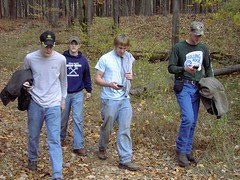
PICT0134
Originally uploaded by P_Linehan.
GPS receivers have become ubiquitous tools for forestry field work to locate forest inventory plots, mark trails, and a host of other tasks. Here students in the Forest Mapping Systems class at Penn State Mont Alto are returning from recording waypoints on a trail in the Michaux State Forest.
Monday, November 06, 2006
Deer Fencing
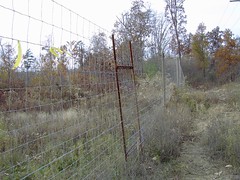
PICT0128
Originally uploaded by P_Linehan.
To regenerate a forest in Pennsylvania deer fencing is a must. Here in the Michaux State Forest next to Penn State Mont Alto campus a deer fence has been set up to allow oak regeneration after a thinning in a pine stand. The gate is to let people in, but keep deer out.
Sunday, November 05, 2006
More forestry tools
More of Jim Nelson's tools. At the center is a chain (66 feet ) made up of 100 links. The rulers are log rules.
) made up of 100 links. The rulers are log rules.
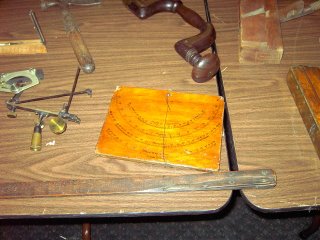 In this photo is a student-made clinometer, possibly from Mont Alto. An old washer provides the plumb weight. The instrument has several scales, such as percent, degrees, and tree height at one chain.
In this photo is a student-made clinometer, possibly from Mont Alto. An old washer provides the plumb weight. The instrument has several scales, such as percent, degrees, and tree height at one chain. 
 ) made up of 100 links. The rulers are log rules.
) made up of 100 links. The rulers are log rules. In this photo is a student-made clinometer, possibly from Mont Alto. An old washer provides the plumb weight. The instrument has several scales, such as percent, degrees, and tree height at one chain.
In this photo is a student-made clinometer, possibly from Mont Alto. An old washer provides the plumb weight. The instrument has several scales, such as percent, degrees, and tree height at one chain. 
Pennsylvania Forest Fire Museum Annual Meeting

Yesterday was the annual meeting of the PFFMA in Chambersburg. Here is the group shot. There were some interesting developments for the museum project. A temporary museum will soon be opening in the old office building at Caledonia State Park.
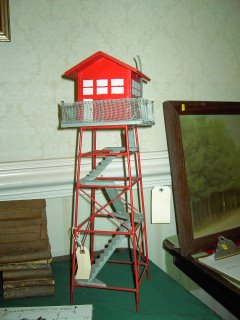
Also, Guilford Township has made available office space in a restored farm building in Norlo Park to the PFFMA
This is part of a display of fire watch towers
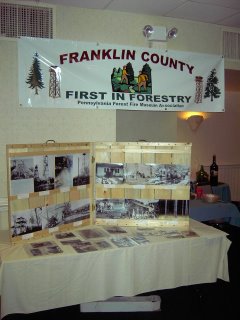 .
. Jim Nelson brought a display of old axes and forestry tools. He described how blacksmiths from the colonization onward modified European methods to make axes adapted to American conditions.
Jim Nelson brought a display of old axes and forestry tools. He described how blacksmiths from the colonization onward modified European methods to make axes adapted to American conditions. 
Thursday, November 02, 2006

Pennsylvania's hardwood forests are among its most valuable resources. Black cherry from PA is famous around the world. The hardwood industry accounts for thousands of jobs and millions of dollars to the economy. It is good to know that there are scientists working hard on conserving and improving hardwood species. The Hardwood Tree Improvement & Regeneration Center at Purdue University http://www.htirc.org (with support from the USDA Forest Service)
Scientists at the center are doing basic and applied research on species such as black walnut, red and white oak, green ash, and many others. Most of their research results are directly available from the web site. This is very handy for students doing research projects and foresters looking for practical information. Here is an article entitled: Successful Stock Production for Forest Regeneration: What Foresters Should Ask Nursery Managers About Their Crops (and Vice Versa).
It's well worth a look.
Subscribe to:
Posts (Atom)

